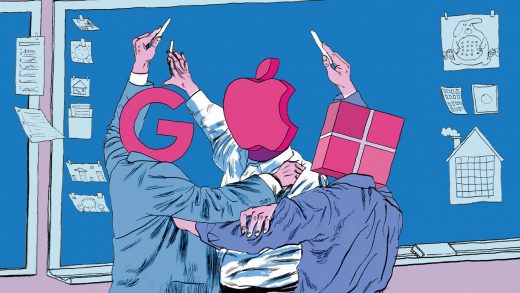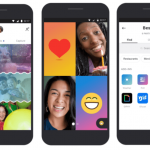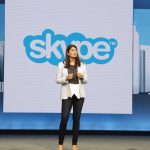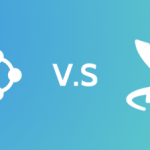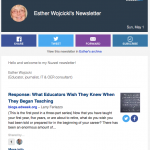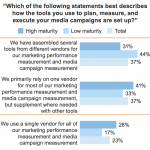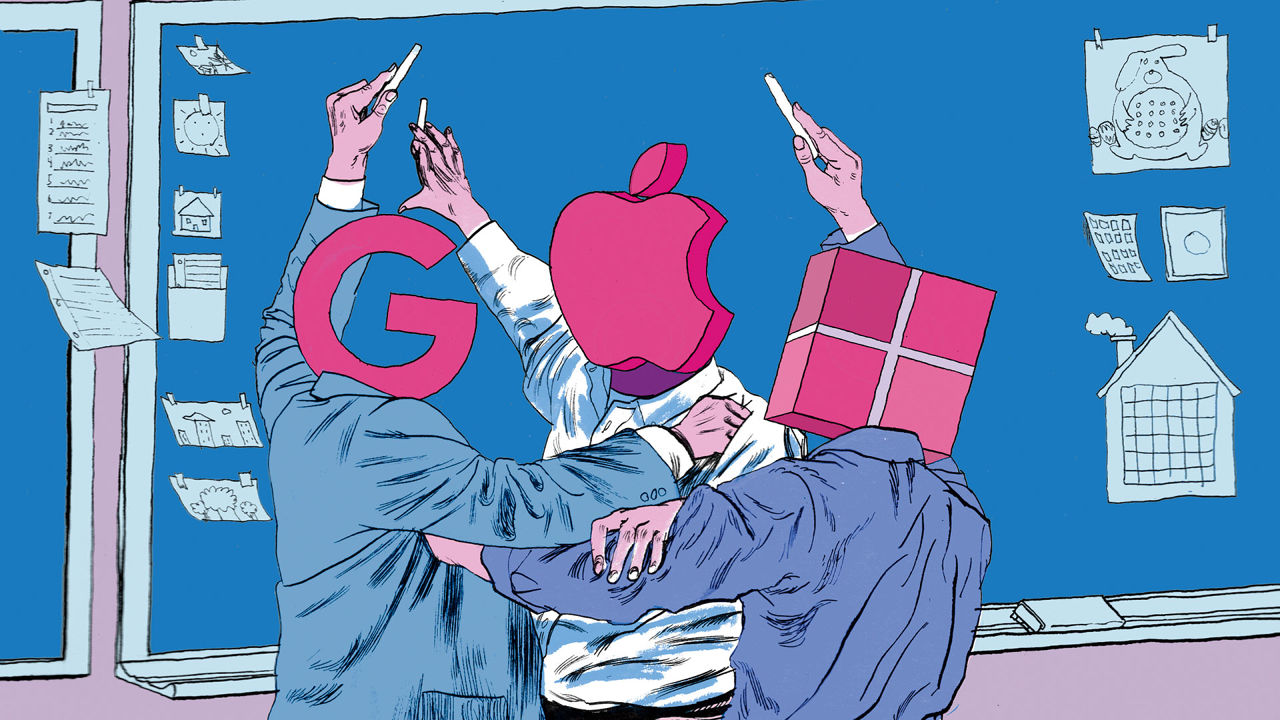How Google Is Schooling Apple And Microsoft In The Battle For America’s Classrooms
A Mozart duet echoes through the dim auditorium of Philadelphia’s String Theory high school, performed by a pair of plaid-skirted violinists reading music off their school-issued iPads. In other classes at the performing-arts-themed public charter school, students use their iPads to plot DNA data, design graphics, and make movies. At first glance, the school is a model Apple education customer, buying into both its hardware and iOS ecosystem.
A more complicated reality lies beneath the tablet glass. Teachers at String Theory distribute curriculum via Apple’s iTunes U—but students use Google Docs and Google Drive to complete and submit assignments. “They get the full App Store experience, and they can also use all the functionality of Google,” says Christine DiPaulo, the school’s director of innovation. “It’s the best of both worlds.”
Apple may not share that perspective. Since the Apple IIe desktop computer found a home in California schools in the ’80s, ushering in the era of the classroom PC, Apple and Microsoft have vied for the attention of American students. With the introduction of the iPad in 2010, Apple had a tool poised to displace the PC as an education essential, and the app-based software to go along with it. Within a few years, the company was selling millions of the touch-screen devices to schools, eclipsing Microsoft, which was marketing its own devices and free Office software to students. In 2013, Apple devices accounted for 50% of shipments to U.S. classrooms, according to research firm Futuresource Consulting. Microsoft, despite its lead globally, came in second at 29%.
It’s an entirely different picture today: Google now dominates K–12 education in the United States, even in schools, like String Theory, that have formal relationships with Apple and Microsoft. Just five years after Google introduced its bare-bones Chromebook laptop—which runs a software suite that includes Gmail, Google Drive, Hangouts, and more, and retails for as low as $150—the search giant has topped both Apple and Microsoft in U.S. education sales. It shipped more than 5 million devices to U.S. buyers in 2015, roughly twice the total of each of its rivals. In the first quarter of 2016, the Chrome operating system’s share of shipments to U.S. classrooms hit 51%—a number that will continue to rise, according to Futuresource.
“This is a real battleground,” says Mike Fisher, Futuresource’s associate director of educational technology. At stake: the roughly $43 billion worldwide market for educational hardware and software, which is expected to double by 2020, even as the global PC market declines and tablet sales slow. And the significance extends beyond the classroom. If students develop familiarity with an operating system at an early age, or so the thinking goes, they will prefer it in their future professional lives. (That’s certainly been Microsoft’s strategy; the company, which still leads education sales outside of the U.S., emphasizes that proficiency with applications like Word and Excel is a critical workplace skill.) Caught on their heels in the U.S., and anxious that Google’s Chromebooks will soon repeat their success overseas, Apple and Microsoft are fighting to regain momentum. First, they need to convince educators that in a world of rapidly changing technology they can give both students and teachers a competitive edge.
In a classic Google move, the company began infiltrating American schools not by selling products, but by giving something away for free. It started wooing teachers in 2006 with Google Apps for Education, a software suite that includes classroom-management tools, along with Gmail and Google Drive. By observing classes and incorporating teachers’ ideas into the products, Google won millions of converts to its education tools. (Facebook began following Google’s footsteps this fall, supporting California’s nonprofit Summit Public Schools charter network in the rollout of learning-management software built with the social network’s engineers.) Google’s resource investment started paying off when the company introduced the Chromebook in 2011 and adopted an unorthodox early distribution strategy. Most education sales in the U.S. happen at the district level and involve months of needs assessment and negotiation before devices are, generally, shipped by the thousands. Google, impatient to gain traction, simply bundled 30 Chromebooks together with a charging cart and a printer and started pitching them to schools. While Apple and Microsoft were waiting for their multimillion-dollar contracts to come up for renewal, enterprising teachers were maneuvering to put the affordable, easy-to-share Chromebooks into students’ hands. “We found teachers who were able to secure budget and go and buy those for their classroom,” says Rajen Sheth, director of product management for Android and Chrome in business and education. “[Chromebooks] were flying off the shelves.”
That initial flurry of interest in the devices turned into an avalanche in 2014 as state-mandated achievement tests moved online. Forced to adapt, districts around the country upgraded their Wi-Fi and snapped up no-frills Chromebooks by the tens of thousands. Today, more than 60 million students worldwide use school-issued education accounts for Google’s standard productivity apps each month, from email to spreadsheets, while their teachers use Google Classroom to create class websites that serve as a central hub for assignments, notes, and more.
The Chromebook has its detractors. Some educators say that browser-focused laptops fail to engage students in the same way as touch-screen devices, like iPads and Surface tablets. Students perceive the iPad as a personalized device that enables creativity, says String Theory cofounder Jason Corosanite—a difference that, in his view, justifies the higher price tag, typically in the range of $400 or more. After Corosanite’s school switched from laptops to iPads in 2011, he says, students’ time spent on tasks, an indicator of learning in progress, “went through the roof.”
Apple executives similarly argue that iPads, with their cameras, gyroscopes, and rich library of apps, are uniquely suited to encourage the kind of creative problem solving that American schools seek to nurture. They can be used for just about any kind of hands-on lesson. “iPad doesn’t have to be left on a desk,” says Susan Prescott, Apple’s vice president of product marketing and applications. “It’s a microscope, it’s a video camera.” With the two-year-old iPad app Playground Physics, for example, students can film friends out on the swings, and then track and analyze their arc of motion. The app, developed by award-winning design studio Local Projects on behalf of the New York Hall of Science, is emblematic of the type of wow-worthy content that first drew educators into the Apple ecosystem.
Such apps still sell iPads. But today, there is good (if not great) educational content available for all the major operating systems. At the same time, teachers and administrators are increasingly interested in the kind of management tools that Google’s Chromebooks are uniquely suited to deliver: setting up student accounts, updating software, grading homework, and more. And with classroom Wi-Fi improving, schools can take advantage of free access to Google’s massive cloud servers, which store student data and sync updates to homework assignments. Plus, administrators can manage the Chromebook remotely—an enormous advantage for short-staffed district technology teams juggling thousands of student and teacher accounts.
In response, Apple has started rolling out its Classroom App, giving teachers the means to control all the devices in a classroom, and has introduced tools that make it easier for schools to generate and manage login IDs. Microsoft also now has a “Classroom” offering as part of its Office 365 Education suite, which provides teachers with a way to organize course materials and to communicate with students and includes the cloud-based collaborative software OneNote, a rival to Google Docs.
This new software may check the right boxes, but Adam Newman, founding partner at education advisory firm Tyton Partners, predicts that Google will retain its edge due to its strong bond with teachers—not to mention its price. He sees a place for Apple as a premium product, “but it will be as a lighthouse, not necessarily as a real share leader.” Microsoft is better positioned, thanks to its global advantage. The challenge, says Newman, is that “there’s a complexity to what Microsoft is offering, and in a lot of places that complexity can be overwhelming.” Teachers just want tech that works, no hassle.
In June, however, Microsoft took a step toward charming teachers—and repositioning itself at the forefront of innovative learning—with the launch of Minecraft: Education Edition. The classroom-oriented version of the popular computer game, which teaches children computational thinking and other STEM building-block skills, is now available for between $1 and $5 per student. (Microsoft acquired the company that developed the game for $2.5 billion in 2014.) “There’s really nothing like it among our competitors,” says Tony Prophet, Microsoft’s corporate vice president for education marketing, adding that the game has generated “huge excitement from educators around the world.”
Google, meanwhile, is onto the next platform. Last year, it began using Google Cardboard to allow students to take virtual-reality “field trips” as part of their regular art, history, and science lessons. Already, more than 1 million students in 11 countries have taken one—and more are on their way.
A version of this article appeared in the October 2016 issue of Fast Company magazine.
Fast Company , Read Full Story
(118)

